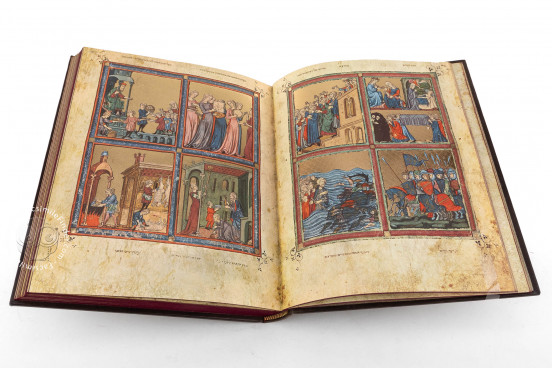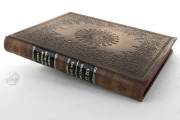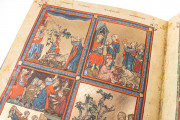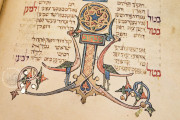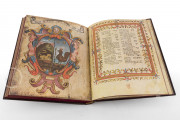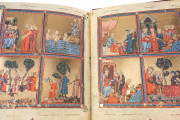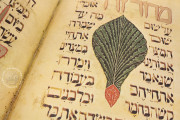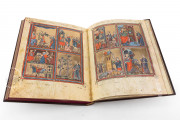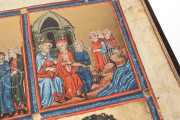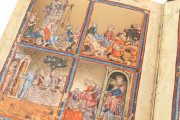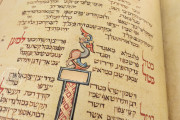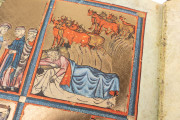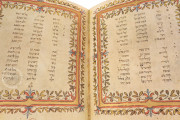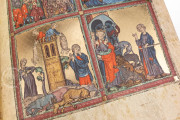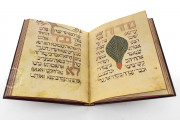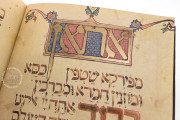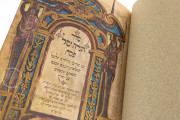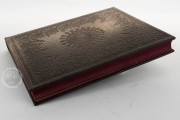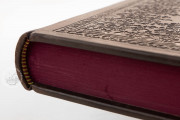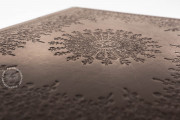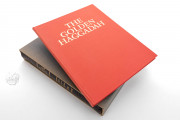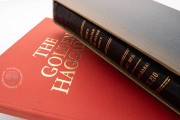A treasure from fourteenth-century Spain, the Golden Haggadah is one of the most richly decorated medieval manuscripts for the celebration of the Jewish Passover seder. Made in Catalonia—perhaps in Barcelona—around 1320-1330, it features an extensive cycle of biblical scenes followed by images of the preparations for Passover arranged in a series of fourteen full-page miniatures; the manuscript is named for the shimmering gold backgrounds of these miniatures. The rest of the manuscript is equally dazzling with text panels featuring gold letters surrounded by colorfully patterned frames and marginal vignettes.
The text is the Haggadah (or "telling"), a collection of biblical, rabbinic, and instructional texts compiled for the celebration of the seder (fols. 24v-55v), accompanied by poems—piyyutim—to be recited during the week of Passover and liturgical texts.
Richly Illustrated Biblical Stories
The most spectacular feature of the Golden Haggadah is its opening series of frontispieces, presented as facing pairs of full-page miniatures, with each miniature divided into four sections, alternating with openings occupied by text added in the seventeenth century. Most of the fifty-six scenes illustrate scenes from Genesis and Exodus extending from Adam Naming the Animals (fol. 2v) to Miriam's Song (fol. 15r). The remaining scenes of the last miniature show contemporary preparations for the seder, including the distribution of matzoth and cleaning the house.
The background of each miniature is in gold leaf with tooling in diaper patterns (repeating geometric designs) in a style learned from French Gothic illumination. The biblical scenes show the influence of contemporary Christian art—for example, in the depiction of the voice of God that addresses Moses from the burning bush as a winged angel (fol. 10v). Nevertheless, much of the iconography reflects rabbinic midrash on the Hebrew scripture.
The text of the Haggadah proper is written in long lines in Hebrew Square Script. The texts of the poems and liturgical texts are written in one, two, or three columns. Major sections of the text open with enlarged letters in gold or silver or particolored in blue, red, and rose featuring rather comical animal heads.
A Text Under Scrutiny
The text of the Golden Haggadah was reviewed by Christian censors on three occasions—in 1599 by Luigi da Bologna, in 1613 by Camillo Jaghel, and in 1626 by Renato da Modena—as attested by their signatures (fol. 101v). Several texts, especially among the liturgical pieces, have been effaced, presumably as a result of this scrutiny.
Created in Spain and Much Later Embellished in Italy
The Golden Haggadah was mostly illuminated in fourteenth-century Catalonia in the Gothic style, but further text and illumination were added in northern Italy in 1602 when the manuscript served as a gift from Joab Gallico to his daughter Rosa: a frontispiece and armorial crest were added (fols. 2r and 16r) as was the text on Passover laws that alternates with the frontispiece miniatures (fols. 3v-15v). The manuscript remained in Italy until 1865 when the British Museum purchased it as part of the extensive manuscript library of the bibliophile Joseph (Josef) Almanzi (1801-1860). The manuscripts in the library of the British Museum were transferred to the newly established British Library in 1973.
We have 1 facsimile edition of the manuscript "Golden Haggadah": Golden Haggadah facsimile edition, published by Eugrammia Press, 1970
Request Info / Price
